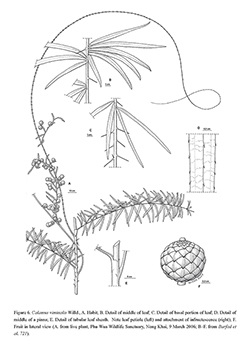e-Flora of Thailand
Volume 11 > Part 3 > Year 2013 > Page 383 > Arecaceae > Calamus
49. Calamus viminalis Willd.wfo-0000761041
Sp. Pl. 2: 203. 1799; Evans et al., A Field Guide to the Rattans of Lao PDR: 24. 2001.— Palmijuncus viminalis (Willd.) Kuntze, Revis. Gen. Pl. 2: 732. 1891.— Rotang viminalis (Willd.) Baill., Hist. Pl. 13: 299. 1895. Plate C: A. Fig. 6.
Accepted Name : This is currently accepted.
Synonyms & Citations :
Description : Clustering slender rattan forming large thickets. Stems climbing to 35 m, without sheaths 0.5–1.5 cm diam., with sheaths 0.9–3 cm diam., internodes 10–30 cm long. Leaves ecirrate; sheaths pale green with abundant caducous white indumentum and sparsely armed with yellowish spines to 4 cm long with reddish tips and swollen yellowish bases; ocrea inconspicuous; knee well developed, armed as the rest of the sheath; flagellum to 3 m long; petiole 5–20 cm long, longer in juvenile stems, armed with spines along the margins and abaxial mid line with spines 1–4 cm long; rachis up to 1.3 m long; leaflets to 55 on each side of the rachis, arranged in groups of 2–4 fanned within the groups, the largest 15–35 (rarely less) by 1–1.5 cm, dark shiny green. Inflorescence to 5 m long including long terminal flagellum, male and female superficially similar but male branched to 3 orders, the female to 2 orders, partial inflorescences to 7 or more, to 30 cm long; male rachillae very short, curved, ca 1 by 0.15 cm, female rachillae 5–1.5 by 0.2 cm, some rachilla bracts subtending two female flowers and 1 sterile male instead of usual dyad. Mature fruit relatively small, rounded, ca 0.8 cm diam., with a beak to 0.1 by 0.1 cm, and covered in 11–12 vertical rows of whitish (when fresh) turning yellowish scales with fine dark margins. Seed globose, ca 0.6 cm diam.; endosperm homogeneous. Seedling leaf with 4 very slender widely separated leaflets.
Thailand : NORTHERN: Chiang Mai, Nakhon Sawan; NORTH-EASTERN: Nong Khai; EASTERN: Chaiyaphum, Nakhon Ratchasima, Surin, Ubon Ratchathani; SOUTH-WESTERN: Kanchanaburi, Phetchaburi; CENTRAL: Saraburi, Nakhon Nayok; SOUTH-EASTERN: Prachin Buri, Chon Buri, Chanthaburi, Trat; PENINSULAR: Nakhon Si Thammarat, Narathiwat.
Distribution : NE India (type), S China to Lesser Sunda Islands (Bali).
Ecology : Village margins, forests edges, dry evergreen forests, to 600 m alt.
Vernacular : Wai khom (หวายขม)(Central, Northern); ro-tae-sa-po (รอแตซาโป๊ะ)(Malay-Narathiwat).
Uses: Edible shoot and fruits; cane used for handicrafts and general cordage.
Conservation Status: Not threatened.
Notes: For differences between this species and Calamus siamensis, see under C. siamensis.


